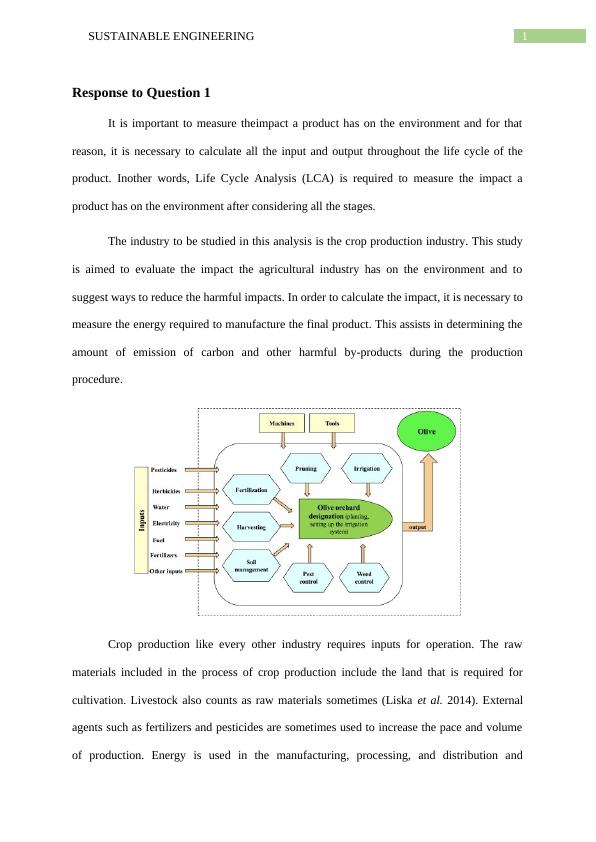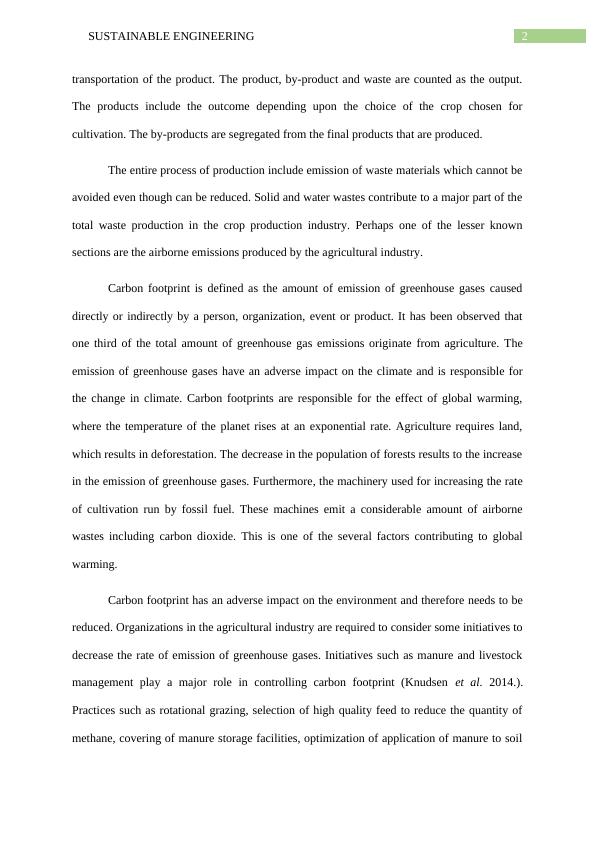Impact of Crop Production and Aviation Industry on Carbon Footprint
Added on 2023-06-10
8 Pages1674 Words399 Views
Running head: SUSTAINABLE ENGINEERING
Sustainable Engineering
Name of Student:
Name of University:
Author Note:
Sustainable Engineering
Name of Student:
Name of University:
Author Note:

1SUSTAINABLE ENGINEERING
Response to Question 1
It is important to measure theimpact a product has on the environment and for that
reason, it is necessary to calculate all the input and output throughout the life cycle of the
product. Inother words, Life Cycle Analysis (LCA) is required to measure the impact a
product has on the environment after considering all the stages.
The industry to be studied in this analysis is the crop production industry. This study
is aimed to evaluate the impact the agricultural industry has on the environment and to
suggest ways to reduce the harmful impacts. In order to calculate the impact, it is necessary to
measure the energy required to manufacture the final product. This assists in determining the
amount of emission of carbon and other harmful by-products during the production
procedure.
Crop production like every other industry requires inputs for operation. The raw
materials included in the process of crop production include the land that is required for
cultivation. Livestock also counts as raw materials sometimes (Liska et al. 2014). External
agents such as fertilizers and pesticides are sometimes used to increase the pace and volume
of production. Energy is used in the manufacturing, processing, and distribution and
Response to Question 1
It is important to measure theimpact a product has on the environment and for that
reason, it is necessary to calculate all the input and output throughout the life cycle of the
product. Inother words, Life Cycle Analysis (LCA) is required to measure the impact a
product has on the environment after considering all the stages.
The industry to be studied in this analysis is the crop production industry. This study
is aimed to evaluate the impact the agricultural industry has on the environment and to
suggest ways to reduce the harmful impacts. In order to calculate the impact, it is necessary to
measure the energy required to manufacture the final product. This assists in determining the
amount of emission of carbon and other harmful by-products during the production
procedure.
Crop production like every other industry requires inputs for operation. The raw
materials included in the process of crop production include the land that is required for
cultivation. Livestock also counts as raw materials sometimes (Liska et al. 2014). External
agents such as fertilizers and pesticides are sometimes used to increase the pace and volume
of production. Energy is used in the manufacturing, processing, and distribution and

2SUSTAINABLE ENGINEERING
transportation of the product. The product, by-product and waste are counted as the output.
The products include the outcome depending upon the choice of the crop chosen for
cultivation. The by-products are segregated from the final products that are produced.
The entire process of production include emission of waste materials which cannot be
avoided even though can be reduced. Solid and water wastes contribute to a major part of the
total waste production in the crop production industry. Perhaps one of the lesser known
sections are the airborne emissions produced by the agricultural industry.
Carbon footprint is defined as the amount of emission of greenhouse gases caused
directly or indirectly by a person, organization, event or product. It has been observed that
one third of the total amount of greenhouse gas emissions originate from agriculture. The
emission of greenhouse gases have an adverse impact on the climate and is responsible for
the change in climate. Carbon footprints are responsible for the effect of global warming,
where the temperature of the planet rises at an exponential rate. Agriculture requires land,
which results in deforestation. The decrease in the population of forests results to the increase
in the emission of greenhouse gases. Furthermore, the machinery used for increasing the rate
of cultivation run by fossil fuel. These machines emit a considerable amount of airborne
wastes including carbon dioxide. This is one of the several factors contributing to global
warming.
Carbon footprint has an adverse impact on the environment and therefore needs to be
reduced. Organizations in the agricultural industry are required to consider some initiatives to
decrease the rate of emission of greenhouse gases. Initiatives such as manure and livestock
management play a major role in controlling carbon footprint (Knudsen et al. 2014.).
Practices such as rotational grazing, selection of high quality feed to reduce the quantity of
methane, covering of manure storage facilities, optimization of application of manure to soil
transportation of the product. The product, by-product and waste are counted as the output.
The products include the outcome depending upon the choice of the crop chosen for
cultivation. The by-products are segregated from the final products that are produced.
The entire process of production include emission of waste materials which cannot be
avoided even though can be reduced. Solid and water wastes contribute to a major part of the
total waste production in the crop production industry. Perhaps one of the lesser known
sections are the airborne emissions produced by the agricultural industry.
Carbon footprint is defined as the amount of emission of greenhouse gases caused
directly or indirectly by a person, organization, event or product. It has been observed that
one third of the total amount of greenhouse gas emissions originate from agriculture. The
emission of greenhouse gases have an adverse impact on the climate and is responsible for
the change in climate. Carbon footprints are responsible for the effect of global warming,
where the temperature of the planet rises at an exponential rate. Agriculture requires land,
which results in deforestation. The decrease in the population of forests results to the increase
in the emission of greenhouse gases. Furthermore, the machinery used for increasing the rate
of cultivation run by fossil fuel. These machines emit a considerable amount of airborne
wastes including carbon dioxide. This is one of the several factors contributing to global
warming.
Carbon footprint has an adverse impact on the environment and therefore needs to be
reduced. Organizations in the agricultural industry are required to consider some initiatives to
decrease the rate of emission of greenhouse gases. Initiatives such as manure and livestock
management play a major role in controlling carbon footprint (Knudsen et al. 2014.).
Practices such as rotational grazing, selection of high quality feed to reduce the quantity of
methane, covering of manure storage facilities, optimization of application of manure to soil

End of preview
Want to access all the pages? Upload your documents or become a member.
Related Documents
Sustainable Studiolg...
|9
|3033
|55
Is Climate Change a Result of Human Activities?lg...
|7
|1635
|166
Essay on Greenhouse Effectlg...
|8
|1815
|132
Climate Change and Business Sustainability: Reducing Carbon Footprintlg...
|6
|1610
|431
Role of Biochar in Plant Growth- Assignmentlg...
|19
|5360
|66
Livestock Greenhouse Gas Emission and Impact of Economic Policieslg...
|7
|2262
|131
